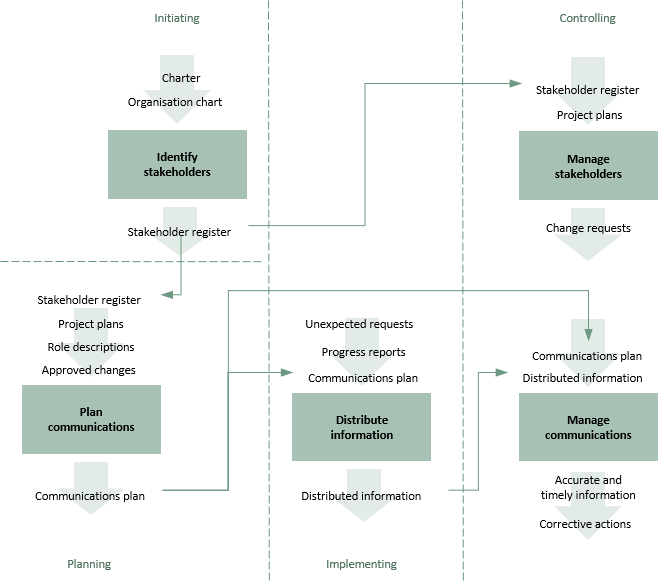Engaging with stakeholders requires communication and stakeholders (in the broadest sense of the term) are the object of all communication. Therefore, it makes sense to look at these two subject areas together.
The mechanics of managing communications are covered by information management in Praxis so that function is also included here.
Praxis also has a separate communication function but this is classed as an interpersonal skill and deals more with the theory of human communication.
The ISO21500 stakeholder subject area contains four processes and the communication subject area contains three.
ISO21500 process groups | |||||
|---|---|---|---|---|---|
Initiating | Planning | Implementing | Controlling | Closing | |
Stakeholder | 4.3.9 Identify stakeholders |
| 4.3.10 Manage stakeholders |
|
|
Communication | 4.3.38 Plan communications | 4.3.30 Distribute information | 4.3.40 Manage communications | ||
In the diagram below, these processes are presented as a flow diagram using the inputs and outputs defined in ISO21500. There are two planning processes and one controlling process.
Click on the diagram for more detail on each process.

The corresponding procedures from Praxis are shown below. It should be noted that the communication function in Praxis deals with the theory of human communication. The Praxis equivalent, of what ISO21500 refers to as communication, is information management.


The Praxis version of this process shows the feedback loops from each step back to the identify step as the management team should regularly review the list of identified stakeholders.
The identify step in the Praxis procedure and the ISO21500 identify stakeholders process are direct equivalents.
The purpose of this process is to identify stakeholders who are directly involved in the work or are simply affected by the objectives of the project or programme and the process of achieving them.
The charter is initially the main input as that will have an initial list of key stakeholders and includes information that will help identify further stakeholders.
To be consistent with other subject area processes identify stakeholders should have approved changes as an input, since these will be one of the things that will trigger a review of the stakeholders in the register. In fact changes should not be approved until the impact on stakeholders has been identified and assessed.
This process combines the assess and engage steps from the Praxis stakeholder management procedure.
The purpose of this process is to assess stakeholders’ needs and expectations, and to understand their influence on the achievement of the objectives.
Any project or programme will have supportive stakeholders and those that are antagonistic towards the work. A project or programme manager must seek to maximise the support from those who are naturally supportive and minimise the impact of those who are not. This will require effective negotiation, conflict management and influencing skills.
Managers will not always have the necessary authority to resolve stakeholder issues and in this instance the manager and sponsor must work together, and potentially call on more senior support where necessary.
This equivalent to this process in Praxis is the plan communications step in the stakeholder management procedure.
Once stakeholders have been identified and assessed, a communications plan should be developed. This will identify what information individual or groups of stakeholders will need and when that information should be distributed.
As the assessment of stakeholder interests and influence takes place as part of the manage stakeholders process, there should really be a link from there to plan communications with an updated stakeholder register.
The nearest equivalent to this process in Praxis is the access and disseminate step in the information management process.
This very simple process ensures that the communications set out in the communications plan are distributed in a timely manner.
It also has to ensure that additional requests for information are captured and addressed.
This process is wide ranging and can be seen as encompassing most of the Praxis information management procedure and the engage step from the stakeholder management procedure.
ISO21500 states that this process should “ensure that the communication needs of the project stakeholders are satisfied and to resolve communication issues if and when they arise.” In this respect it duplicates the distribute information process and it is somewhat misleading to see these as separate processes. It also overlaps significantly with manage stakeholders.
The objectives of this process are to:
- promote understanding and co-operation among stakeholders;
- provide accurate and impartial information in accordance with the communication plan;
- minimise the impact of communication issues and misunderstandings.
These high level objectives are shared with several other processes.





